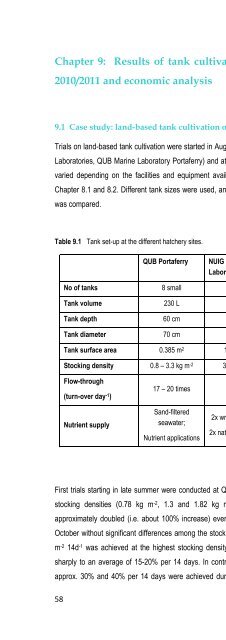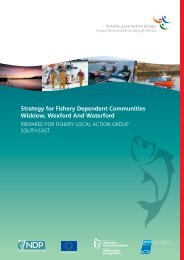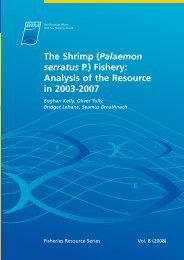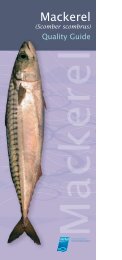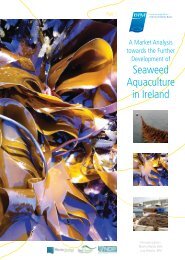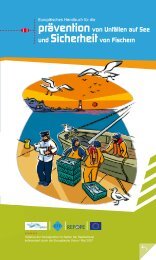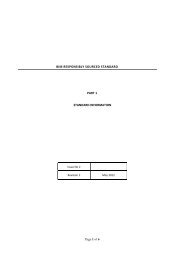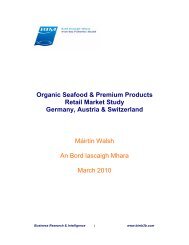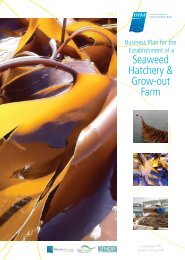Cultivating Palmaria palmata - Bord Iascaigh Mhara
Cultivating Palmaria palmata - Bord Iascaigh Mhara
Cultivating Palmaria palmata - Bord Iascaigh Mhara
Create successful ePaper yourself
Turn your PDF publications into a flip-book with our unique Google optimized e-Paper software.
Chapter 9: Results of tank cultivation trials of <strong>Palmaria</strong> <strong>palmata</strong> in<br />
2010/2011 and economic analysis<br />
9.1 Case study: land-based tank cultivation of <strong>Palmaria</strong> <strong>palmata</strong>: Summary of results<br />
Trials on land-based tank cultivation were started in August 2010 at the three hatcheries (DOMMRS, MRI Carna<br />
Laboratories, QUB Marine Laboratory Portaferry) and at Cartron Point Shellfish Ltd., Co. Clare. The tank set-up<br />
varied depending on the facilities and equipment available (Table 9.1) but followed the recommendations in<br />
Chapter 8.1 and 8.2. Different tank sizes were used, and growth in both natural and nutrient-enriched seawater<br />
was compared.<br />
Table 9.1 Tank set-up at the different hatchery sites.<br />
58<br />
QUB Portaferry NUIG Carna<br />
Laboratories<br />
DOMMRS Cartron Point<br />
Shellfish<br />
No of tanks 8 small 4 large 2 large 2 large<br />
Tank volume 230 L 1000 L 1000 L 1000 L<br />
Tank depth 60 cm 90 cm 90 cm 90 cm<br />
Tank diameter 70 cm 119 cm 119 cm 119 cm<br />
Tank surface area 0.385 m 2 1.112 m 2 1.112 m 2 1.112 m 2<br />
Stocking density 0.8 – 3.3 kg m -2 3.6 kg m -2 3.6 kg m -2 1.8 kg m -2<br />
Flow-through<br />
(turn-over day -1 )<br />
Nutrient supply<br />
17 – 20 times 7 - 15 8 - 9 times 8 - 9 times<br />
Sand-filtered<br />
seawater;<br />
Nutrient applications<br />
2x wrasse effluent<br />
2x natural seawater<br />
Raw seawater +<br />
slow release<br />
fertiliser<br />
Sand-filtered<br />
seawater + slow<br />
release fertiliser<br />
First trials starting in late summer were conducted at QUB Portaferry, using high seawater flow rates, different<br />
stocking densities (0.78 kg m -2 , 1.3 and 1.82 kg m -2 ) and no additional nutrient supply. The biomass<br />
approximately doubled (i.e. about 100% increase) every 14 days over a 2-month period between August and<br />
October without significant differences among the stocking densities (Table 9.2). A maximum yield of 2 kg FW<br />
m -2 14d -1 was achieved at the highest stocking density in September. From October onwards, yield dropped<br />
sharply to an average of 15-20% per 14 days. In contrast, at DOMMRS and Cartron Point Shellfish, yields of<br />
approx. 30% and 40% per 14 days were achieved during November and December 2010. Additional nutrient


